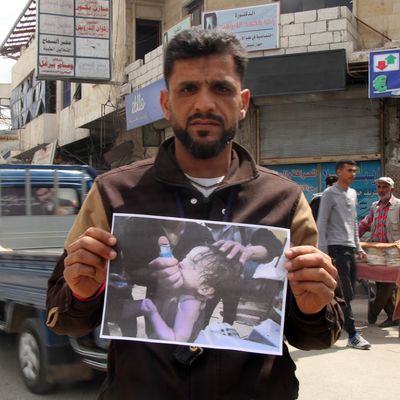
There’s no shortage of reasons to be appalled by President Trump announcing on Wednesday that he plans to launch missiles at Syria. It’s likely the first time such a declaration has been made on Twitter, he doesn’t have congressional authorization to conduct the strike, one of our closest allies wasn’t onboard yet, and the move increases the chances of the U.S. getting into a shooting war with Russia. One other fundamental issue that hasn’t been getting enough consideration is that we still don’t know exactly what happened in Douma, Syria, on Saturday.
Eyewitness reports, photos, and videos of limp children and people struggling to breathe make it apparent that an atrocity occurred in Douma (though Syria and its allies claim it’s all a hoax). But tragically, Syrians have been subjected to horrors throughout their country’s seven-year civil war, and in the world of international relations, the nature of the chemical weapons allegedly used by Bashar al-Assad’s forces last weekend matters. The State Department said the victims’ injuries appear to be “consistent with an asphyxiation agent and of a nerve agent of some type.” However, so far no one has said definitively that the attack was different from the chlorine attacks on Syrians that the international community regularly ignores. Here’s what we know:
Syria Has a Long History of Using Chemical Weapons
Syria began developing its chemical weapons program in the 1970s with help from the Soviet Union in Egypt, and was believed to have one of the largest stockpiles in the world. Syria only admitted this in 2012, though its foreign ministry claimed the weapons were only for responding to “external aggression.”
The Syrian government denies ever using chemical weapons during its civil war, and says it got rid of all its stockpiles in 2013, when it ratified the 1997 Chemical Weapons Convention banning the production, storage, and use of chemical weapons.
That move was what resulted from the Assad regime crossing President Obama’s “red line” by using sarin to kill an estimated 1,429 people in the Damascus suburbs in 2013. Obama considered a military response, but the situation was resolved when the U.S. and Russia brokered a deal to have Syria destroy its chemical weapons.
Why Syria Wasn’t Fully Disarmed of Chemical Weapons
Inspectors seized and destroyed 1,300 metric tons of banned materials after Syria signed the Chemical Weapons Convention. That limited Assad’s capabilities, but as Wired explains, completely disarming him isn’t really possible.
Producing sarin, a nerve agent developed by Nazi Germany, isn’t tremendously difficult and doesn’t require a large facility. A small amount can do massive damage, so it wouldn’t be too hard to hide it from inspectors. International monitors have the right to inspect any facility in Syria on short notice, but that’s physically and politically tricky in the middle of a civil war. Russia and China have repeatedly blocked efforts to hold Syria accountable for its chemical weapons use in the United Nations.
Another complication: chlorine isn’t banned under the Chemical Weapons Convention, as it has many legitimate uses. Using the substance as a chemical weapon isn’t allowed, of course, but there have been dozens of reports of Assad’s forces using it in opposition-held areas since 2013.
The Difference Between Using Chlorine and a Nerve Agent
As the U.N. focused on eliminating Syria’s banned chemical weapons, Assad’s forces shifted to using cruder chlorine bombs, according to Reuters. Sarin has no smell or taste, and causes death through asphyxiation. When inhaled, chlorine turns to hydrochloric acid in the lungs, which can cause drowning from fluid buildup. While chlorine works more slowly and is less efficient than sarin, both can kill.
U.S. officials have avoided saying explicitly whether chlorine attacks — which have become a regular occurrence — should be treated differently from sarin attacks. But that’s been the attitude among many leaders and diplomats, according to Tobias Schneider, an independent analyst who has tracked the reported chlorine attacks. “Even though officials have been loath to admit it, the prohibition against chemical weapons use in Syria has in the past been understood to only pertain to highly lethal nerve agents such as sarin but not the easily produced and far less deadly chlorine,” he told the Post.
As CBS News notes, the Trump administration’s official policy is that the use of any chemical weapon is illegal and would warrant a military response. However, if it’s determined that sarin was involved, the reaction might be more severe. Trump ordered an airstrike on Syria a year ago when it was found that a substance like sarin killed around 80 people in Khan Shaykhun, but since then there’s been no military response to alleged chlorine attacks.
Evidence About the Chemicals Used in Douma
The World Health Organization said that about 500 people in Douma were treated for “signs and symptoms consistent with exposure to toxic chemicals” over the weekend. According to the WHO’s local health partners, of the 70 people who died, 43 showed symptoms “related to symptoms consistent with exposure to highly toxic chemicals.”
There’s significant evidence that chlorine was involved in two bombings, which took place several hours apart. Witnesses described smelling chlorine during the bombings, but as the Post reported, it seemed different from the usual chlorine attacks:
The victims emitted a powerful smell of chlorine, but there were more people affected than in previous chlorine attacks, said Mohammed Marhoum, a medical worker. He saw around 70 and said six of them died.
They also seemed to be more severely affected than those he had treated after previous chlorine attacks, and they displayed symptoms he had never seen before. Some were twitching, others had abnormal pupils, and some were foaming at the mouth. Several arrived at the hospital unconscious.
He and the other medical workers began to suspect that whatever killed them may have been stronger than chlorine. “We believe the gas used was chlorine and another kind of gas,” he said.
Alastair W.M. Hay, a professor of toxicology at Leeds University, said the images of dozens of bodies with foam at the mouth but no other injuries were more consistent with nerve agent exposure than a chlorine attack. “That’s suggestive of something that was very toxic, and people have pretty much died where they were when they inhaled the agent,” he said. “They’ve just dropped dead.”
“Chlorine victims usually manage to get out to somewhere they can get treatment,” Hay added, while viewing video of casualties who died in a basement apartment. “Nerve agent kills pretty instantly.”
Other videos from the scene show large yellow cylinders characteristic of a chlorine attack, with no obvious signs of modification to carry a nerve agent.
“We’re looking at the possibility that there were separate canisters inside the cylinder,” one regional official told The Guardian. “[The contents] cannot be mixed, because that would be volatile and unstable, but they can be combined. That’s a working theory – that they were in the same cylinder but kept separately. The point of detonation dispersed them together. We’ve seen this happen elsewhere in the country, but it didn’t cause a death toll like this. We’re in this situation because those poor people were trapped in a basement where they had no chance.”
Could the Douma Attack Be a Hoax?
The Syrian government and its ally Russia have denied that chemical weapons were used, or that Assad’s forces had anything to do with an attack. After Russian military police visited the site of the attack on Monday, the Russian Ministry of Defense claimed it had “refuted all reports of chemical weapons use in the city,” and called all evidence to the contrary “fake.”
However, the New York Times reported that eyewitness reports, more than 20 videos, and an examination of flight records by citizen observers suggested that Assad’s forces dropped some kind of chemical compound on the area as part of their ongoing effort to break the will of Douma’s rebels:
A number of residents recalled hearing the sounds of helicopters near the time of the attack. A network of citizen observers that tracks Syrian aircraft said that two Mil Mi-8 helicopters, which they said belonged to the Syrian government, had been seen flying from the Dumayr air base toward Douma near the time of the attack.
It’s not entirely clear why Assad’s forces would conduct a particularly deadly chemical attack when he could have retaken Douma with standard bombs and avoided international uproar — though some have suggested the Syrian president was emboldened by Trump’s talk of troop withdrawal.
As The Independent notes, it’s true that Western media sometimes present the accounts of opposition supporters as unbiased eyewitnesses, but Russia and Syria haven’t presented any evidence to back up their claims of a vast conspiracy to fake a gas attack.
What It Will Take to Get Answers
The window for getting a decisive answer on what happened in Douma may have already closed. After Saturday’s attack, the city’s remaining rebels surrendered, and Russian troops moved in. The Organization for the Prohibition of Chemical Weapons said it had accepted the Syrian government’s invitation to come and investigate, and would travel to Douma “soon.” However, since the Russians were already on the site, many doubt that any meaningful evidence will remain.
The Financial Times reported that journalists were having difficulty contacting sources on the ground, and Syrian activists accused the government of purposely cutting communication lines.
By this point, many of the medical workers and activists who were on hand in the aftermath of the attack have dispersed. Dr. Ahmad Tarakji, president of the Syrian American Medical Society, noted that with Assad’s forces heading back in, many locals are too afraid to talk. “You are witnessing the transition of the town,” he said. “You can’t speak against the government.”






























